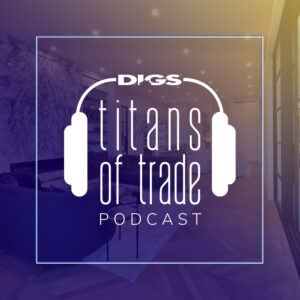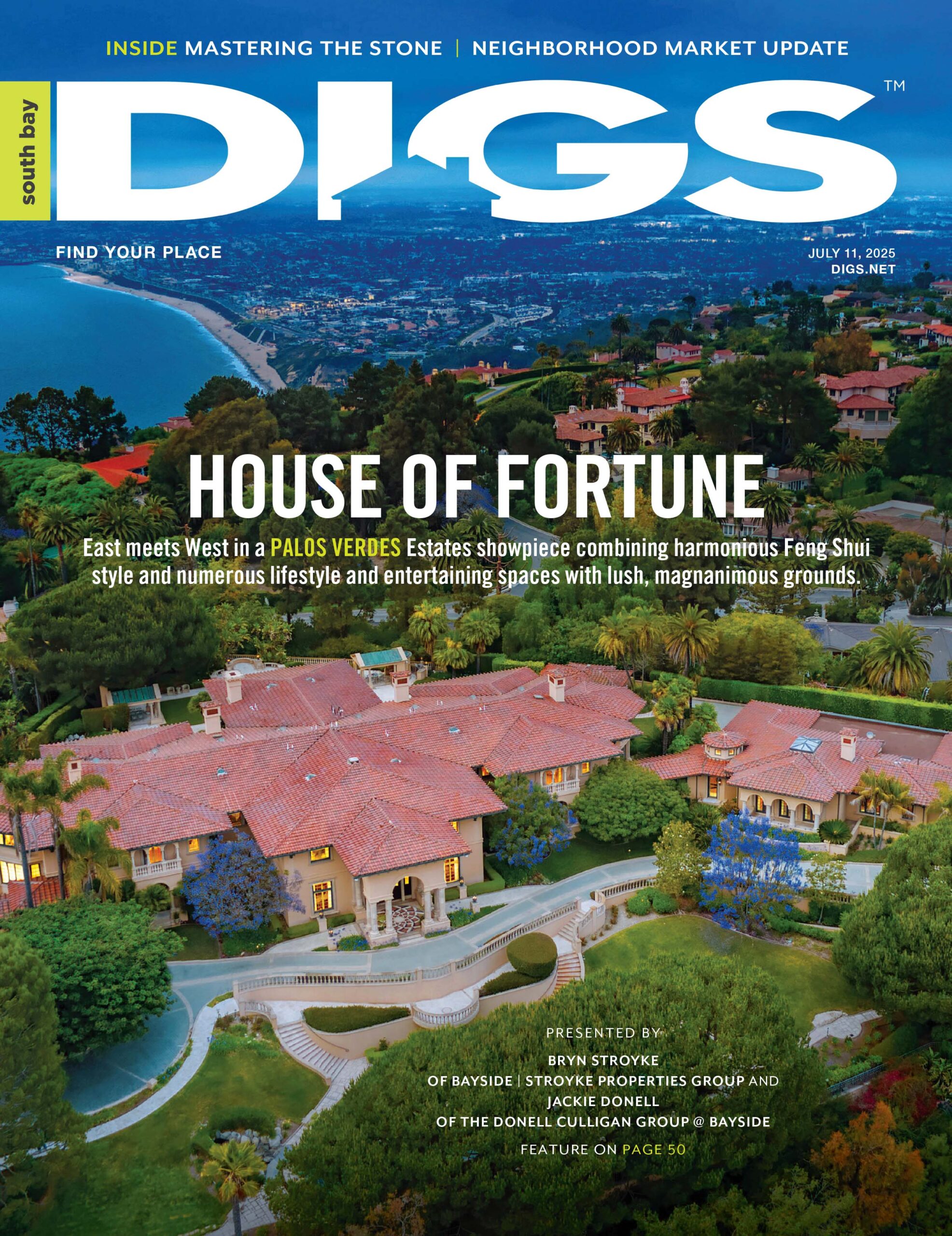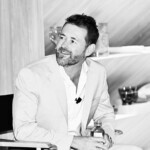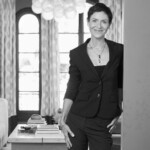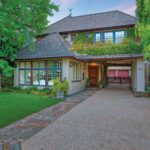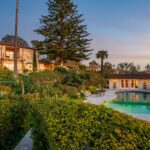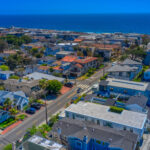In this Episode
Meet award-winning architect, Kevin Holland, Principal in charge at HMC Architects, AIA national board member, mentor and industry shaper. Kevin joins us to discuss his work creating public and civic spaces, as well as being part of positively impacting the industry from the inside, and helping to usher in new architects joining its ranks.
Architecture was an early decision for Holland, who first encountered that ideal touchstone of the art, Frank Lloyd Wright’s Fallingwater, the summer before entering the University of Virginia as an architecture major.
“I still remember looking at the first image, and then when I saw that it was built in 1929, I was floored,” he recounts. “I was absolutely convinced that it was a contemporary building built sometime in my lifetime.”
For the last three decades Kevin Holland’s been involved in private and public projects, yet at one point made a full-time shift to projects where he could integrate the interests and perspectives of more than a single client.
“Sometime in my career the wheels started turning,” says the architect. “I was able to pivot and find some of those project types that enabled me to serve the community at large.”
He’s currently the Principal in Charge at HMC Architects in Los Angeles and shares the ideas driving the agency’s central premise—Design for Good. Particularly how it shapes its work in higher education, K-12, and what they call their “community + culture” practice areas.
“For us,” explains Kevin Holland, “‘Design for Good’ encapsulates everything we believe about serving the public at large, not just that single client who may have contracted us. All of our projects are very democratic.”
Being part of AIA’s National Board of Directors is just another stop in what’s been another career-long engagement for Kevin Holland: helping to advance an industry he loves.
“That sense of providing for the person coming behind you has always been there,” he says. It’s a template of service that was passed to him via his grandfather and mother. “They instilled in me through their example of community service,” he points out, which for him includes being part of the National Organization of Minority Architects (NOMA), of which he was president, the Dean’s Advisory Board for the Tuskegee University School of Architecture as well as the Dean’s Advisory Board at his alma mater, UVA.
Finally, when asked to recall something that surprised him about architecture back when he first entered the industry, he says it was the role of consultants, those involved with the structural engineering of a project—and offers a word of advice to new architects.
“I think that dance and interacting with other people is the one thing you have to learn,” offers Kevin Holland. “You have to learn how much of it is under your control, and how much of it is under someone else’s control. And what is negotiable.”
Follow Kevin Holland
HMC Architects: hmcarchitects.com
LinkedIn: linkedin.com/in/kevinmhollandaia
Full Episode Transcript
Constance Dunn (00:01.406)
Welcome to Titans of Trade. I’m your host, Constance Dunn, and today we welcome an architect who is not only creating amazing buildings, he is also shaping communities and careers as well. Welcome, Kevin Holland.
Kevin Holland (00:13.533)
Hi Constance, thank you for having me.
Constance Dunn (00:15.634)
Yeah, you know, the challenge here will be, I have so much I want to talk with you about. So I’ll have to make sure I like, cause we could talk through the weekend. So you’re in Los Angeles now, and it’s, you’ve done so many different projects throughout the country. And now you’re in LA because you’re with HMC, you’re the principal in charge. And I’m curious about just, as not just a-
Kevin Holland (00:26.794)
Hahaha.
Constance Dunn (00:42.478)
person, but also an architect. What is interesting to you about the city? Like what’s like, huh, this is different.
Kevin Holland (00:51.415)
Okay, okay. Architecturally, you know, I will say that for a city of its size, I would love to see more iconic high-rise buildings. You know, we’re not as dense as Chicago and New York, and there are a few Fortune 500s here in the county, but I believe only three of them are in the city. And so as a result, our high-rises, we don’t have as many iconic high-rises as, say, New York City, which you would expect of a city.
Constance Dunn (01:16.706)
Mm-hmm.
Kevin Holland (01:20.879)
the size of Los Angeles. We do have some really great ones, right? The US Bank building, actually the building that, which is the building that my firm is in, our firm is in, as well as the Intercontinental Hotel, which is a fabulous building in downtown Los Angeles. And so that’s the thing that surprised me when I got here, but I’d be remiss if I made that sound like the city of Los Angeles does not have great architecture, and it has phenomenal.
Constance Dunn (01:22.802)
All right.
Constance Dunn (01:32.822)
Yeah.
Kevin Holland (01:50.307)
phenomenal, fantastic architecture. Many other iconic buildings, LA City Hall, which everyone has seen, opening credits of maybe your favorite detective show based in Los Angeles, right? The Getty out in Santa Monica, the Griffith Observatory, Rafael Meneo has a beautiful Cathedral of the Ladies, Cathedral of Our Ladies of the Angels. That church is just off of the 101 in downtown.
Constance Dunn (01:56.566)
Yeah.
Constance Dunn (02:03.628)
Mm-hmm.
Constance Dunn (02:16.438)
Mm.
Kevin Holland (02:20.471)
Frank Gehry has the Disney Concert Hall, another iconic building. And then of course, the international theme building out at LAX, which is a Paul Williams, which is Paul Williams project. And so between the theme building and the concert hall, those are probably two of the most iconic buildings, not just in Los Angeles, but potentially in the world. And LA is I’ve always said LA is certainly the home of the custom residential, right? There’s a lot of
Constance Dunn (02:22.643)
Yeah.
Constance Dunn (02:40.97)
Right.
Constance Dunn (02:46.866)
Yeah. Yep.
Kevin Holland (02:48.879)
beautiful houses in the hills and there’s a lot of great firms that are doing work in that space.
Constance Dunn (02:55.678)
Yeah, you know, it’s funny about that point you talk about the custom homes is it always occurred to me in Los Angeles that it’s kind of a place where people come from all over the world to make their dreams come true, right? And then when it when it happens, they harken back to the image in their mind of what success would be and what their house would look like, right? And then they create that dream house and there you have it. Yeah.
Kevin Holland (03:07.694)
Sure.
Kevin Holland (03:20.368)
That’s right. This is the place to do it. This is the place to do it, right? And there’s enough hillside that not only can you design the home of your dream, but then you have fantastic views, right? Once you’re up in the hills, and like I said, there’s a lot of hills surrounding Los Angeles. So there’s a lot of people who have beautiful views of either the valley to the north or the basin, or the basin to the south, which is where the city of Los Angeles that resides in the basin.
Constance Dunn (03:31.498)
Right, right.
Constance Dunn (03:38.318)
Great.
Constance Dunn (03:43.832)
Yeah.
Constance Dunn (03:47.766)
Right. And so I know you work in so many areas, not just as an architect, but you’re also very, you’re very involved in kind of this idea of connecting with communities, so connecting designs to communities, which I think is very important for a slew of reasons. And I’m curious about how that started for you.
Kevin Holland (04:16.759)
Well, let’s see. So if we go all the way back, my interest in architecture at a very young age was just based on the fact that I loved to draw and it just seemed like a really cool thing to do, right? I didn’t have any, I didn’t have, I didn’t start off with noble intentions, right? I was a kid, looks like something I can do and it should be fun. But as I got older, once I entered college, I became extremely fascinated with Frank Lloyd Wright’s.
Constance Dunn (04:16.802)
The it, you know.
Kevin Holland (04:45.235)
Falling Water and realized, and in the back of my mind, I realized, yeah, that was a house that he designed for a very wealthy family, the Kaufman family out of Pittsburgh. Then I became really interested in museums done by Richard Meyer, like the Athenaeum or the High. And again, in the back of my mind, I realized, yeah, this is something that was done for a very wealthy patron base, right? And so I start to realize, wait a minute. You know, there’s…
Constance Dunn (04:53.336)
Mm-hmm.
Kevin Holland (05:14.395)
there’s an entire population of people who aren’t necessarily being served on a regular basis. I mean, we do what we can within the profession, but I kind of realized, I’d like to, I’d love to do those museums. I’d love to do those custom homes for those who live in the hills, but I realized that there was a community of people who I wasn’t necessarily doing work for. And so I was trying to figure out how do I.
Constance Dunn (05:22.573)
Mm-hmm.
Constance Dunn (05:41.846)
Right.
Kevin Holland (05:43.495)
do I do that? How do I begin to engage them? And so for me, the first, the project type that initially allowed me to serve that community was education, right? Education K-12, even education higher ed. But K-12 is, you know, it’s very democratic, right? It serves the larger community and not just a very…
Constance Dunn (05:57.896)
Mm-hmm.
Kevin Holland (06:12.467)
specific client base or patron base, right? And so once I found out that was the way architecturally that I could begin to contribute to the community, whether it was the community I was directly or immediately from or any of my new adopted communities, because I’ve lived in a few places. I’ve lived in Ohio as well as California.
Constance Dunn (06:17.165)
Right.
Constance Dunn (06:27.79)
Bye.
Right.
Right. Yeah. Right. And so you also have done a lot of work as K through 12. And then like healthcare is another area where you have like a lot of experience. And I’m kind of curious how a person who’s a designer, right, or an architect, and they’re wanting to integrate other points of view, all points of view, or as many
points of light out there in the community as they could. What are some kind of tactics, some kind of strategies that you could hear from people who might not be used to making their voices heard? Or like connecting with these groups and getting their information, you know, while you’re getting the design. I know that’s very broad, but I’m curious.
Kevin Holland (07:22.351)
Sure. Well, not as much in healthcare because there, there we’re focused on the healthcare system. They’re our client. We normally talk with them about what their goals are, what their needs are, what their objectives are. And we do that with everyone. But, but it’s the, it’s more the public projects where the community involvement is, is sought after. And in some of those projects where it’s not sought after, there tends to be problems, right? It’s something
Constance Dunn (07:37.631)
Mm-mm.
Constance Dunn (07:45.506)
Yeah.
Constance Dunn (07:50.716)
Is that right?
Kevin Holland (07:52.591)
At some point, someone’s going to say, well, you never talked to us about it. And so we don’t necessarily agree with your design solution or even that the project should exist here. So schools rely on school boards. School boards rely on the public. So it’s obvious when you’re doing a school project for us that we’re always going to have to have some community engagement.
Constance Dunn (08:14.813)
Mm-hmm.
Constance Dunn (08:21.272)
Right.
Kevin Holland (08:21.987)
right, in which we’re looking to solicit ideas and responses, not necessarily in the design, but in the impact and the outcome, right? What are you looking for there, right? We want this type of feel. We want a school that will also serve as a community center. So we don’t necessarily get in, we don’t necessarily speak with the community about…
Constance Dunn (08:33.154)
Right.
Constance Dunn (08:44.739)
Mm-hmm.
Kevin Holland (08:51.311)
their design preferences, right? But just what’s the function of the building? How do you wanna engage with the building? And that conversation is going just as much to the school board as it is to us, because in the end, on a school project, the school is our client, right? We’re just all smart enough to realize that there is another client who may not be paying any of the invoices, but there’s another client and they’re called the public. Right?
Constance Dunn (08:53.473)
Mm-hmm.
Constance Dunn (09:07.431)
Mm-hmm.
Constance Dunn (09:18.631)
Mm, right.
Kevin Holland (09:21.219)
And so any opportunity that we have to engage them and to hear their thoughts, we’ll take that and we’ll decipher intent and meaning, and then we’ll try to come up with a solution that meets not only the school’s criteria, but also let’s try to meet some of the criteria of the public that this building will be serving.
Constance Dunn (09:35.661)
Right.
Constance Dunn (09:48.213)
And what’s so interesting about what you’re doing as well is that…
Connecting the spirit of a community to a building, I think is particularly important. And I’m just talking about the aesthetics right now, because there’s such a homogenization. Like I remember in the past, when I traveled for work, you might wanna go pick something up at a boutique for like my niece or something. Let’s just say you’re in Indianapolis and you wanna get something that’s different that she can’t find in Boston. And you notice more and more, it’s just.
Kevin Holland (09:57.912)
Mm-hmm.
Kevin Holland (10:12.33)
Sure.
Constance Dunn (10:20.834)
You know, you didn’t go to a city to go look at a chain store, you know, and there’s a lot of that now. You know, you see a lot of homogenization and I think so it’s important what you’re doing is.
echoing, I guess, or mirroring what is the spirit of a community. And also that also integrates the past as well. Preservation. It’s very interesting. And I’m sorry, it’s a long way around talking about something called equity justice. And if you could just kind of tell us what that’s about or design justice, rather design equity. Forgive me.
Kevin Holland (10:57.471)
There are probably multiple definitions. I’ve heard design equity. I’ve heard design justice. I’ve heard environmental justice. And so it can be a really, really broad tent that encompasses all sorts of attempts to just be fair in the built environment. So if I had to sum it up, that’s it. It’s being fair in the built environment. Now, what does that mean?
Constance Dunn (11:06.263)
Mm-hmm.
Constance Dunn (11:19.968)
Right.
Constance Dunn (11:23.871)
Right.
Kevin Holland (11:26.531)
Well, there are, let’s take Flint, Michigan, right? And the contaminated water. Well, there is a community that is greatly impacted by that contamination more so than say other communities. So the environmentally just thing, taking environmental justice, the environmentally just thing to do is to rectify
Constance Dunn (11:30.976)
Okay.
Constance Dunn (11:37.335)
Right.
Constance Dunn (11:45.946)
Mm-hmm.
Kevin Holland (11:54.727)
amount of contamination in the water, replace the lead line pipes, and then on the back end also to provide medical care for those people who have been affected, right? You don’t just resolve the problem and say, okay, well, there’s no more lead and we’re done, we wipe our hands clean. Because now there has been an impact to some people. Some people have been damaged, some people have been hurt. And so the restitution and making people whole is the other part.
Constance Dunn (12:14.347)
Right, right.
Kevin Holland (12:24.879)
of justice, whether it’s environmental justice, design justice, whatever adjective you want to put in front of the word justice, right, restoring people to being whole is also a part of it. And so design justice is just designing fair and equitable spaces for people. And in many cases, it is correcting a previous wrong.
Constance Dunn (12:37.23)
Right.
Constance Dunn (12:50.886)
Interesting. Now, HMC has a, it’s like a working premise, I guess, or philosophy called designing for good. Is that right? So yeah, and it’s so many of the projects, I saw that HMC was involved with like a competition related to, I’m sorry, tell us about it, because it was very interesting, because it goes into this idea of recalling the past.
Kevin Holland (13:00.891)
That is correct.
Constance Dunn (13:20.022)
forgotten communities and bringing that to light in a very, very interesting way. And I’m curious about you telling us, you know, how the firm was involved, how you were involved.
Kevin Holland (13:33.035)
Okay, I did not have much involvement. In fact, it’s fair to say I had almost zero involvement other than I sat with some of our emerging professionals who actually led this project. Let me start there. This project, we won a merit award, AIA California Merit Award, which is a very distinguished honor, and we’re extremely pleased with that.
Constance Dunn (13:35.63)
Mm-hmm.
Kevin Holland (14:02.267)
that was in the professional category. So there was a high school, a college, a grad student, and then a professional. And so we won the merit award. We won that with emerging professionals, meaning these were some of our most junior staff members who put this project together and on a national scale took a second place award.
Constance Dunn (14:07.394)
Hmm.
Kevin Holland (14:25.303)
right, against firms who more than likely had their design principles involved, some more experienced people. So these are, these were some of our, these are some of our younger and some of our youngest emerging professionals. And so I’m always excited every time, every time I think of the fact that we placed that highly with that, with, with a team that young. But the award was, the project was the AIA California sponsored, and it was also sponsored by I believe,
Constance Dunn (14:29.704)
Ah.
Kevin Holland (14:54.963)
SoCal Edison, San Diego Energy, a couple of utilities, a few utilities were also part of that. But the competition engaged architects, designers, engineers, planners in the pursuit of sustainable design and attempted to celebrate the decarbonization and equity. The challenge this year was to design an agriculture center for Allensworth.
California, which was California’s first African-American town, which unfortunately was intentionally was intentionally stripped of its local train stops, its grocery stores and water rights. So it was stripped of those things, which essentially turned what was once what was once a once thriving community into a forgotten barren land and very much like Plinth.
Constance Dunn (15:25.474)
Hmm.
Constance Dunn (15:34.53)
Wow.
Kevin Holland (15:52.655)
Flint was plagued with arsenic contamination. And so that was the site that was chosen. And so we were really proud of our response to the issues there in Allenworth. And so extremely pleased that we were able to win the medal.
Constance Dunn (16:18.218)
Yeah, absolutely. And there’s something about your personal work which kind of struck me. You do spiritual buildings as well.
Kevin Holland (16:29.611)
I have done a few churches in my career. I haven’t done many in the past, I haven’t done any in the past 10 years. But that was something I really enjoyed early on, early in my career being able to do.
Constance Dunn (16:29.762)
Uh huh.
Constance Dunn (16:40.363)
Right.
Constance Dunn (16:46.386)
Yeah. Right, right. And, you know, you mentioned that one of your first, I guess, interests was falling water, like the perfection of falling water. I was there a few weeks ago. And you know how you walk over to the side of the building, and there’s that view, you know, the view with the and it’s, and it’s just it’s perfection, isn’t it? If if one aspect, you know, if one of the, I guess, I don’t know if it’s a balcony or, you know, was out.
Kevin Holland (17:08.951)
It is. It is.
Constance Dunn (17:16.39)
half of a foot, it wouldn’t be that perfection. Like, you could sit there and look at falling water, the perfection of it, for, I just, you could just be there forever, right? And I’m curious, when you, when did you meet falling water?
Kevin Holland (17:33.163)
I met Fallingwater in a publication when I was 17 or 18. The summer before I started college at the University of Virginia, I interned with the DuPont Company in my hometown of Wilmington, Delaware. And my manager at the time was a woman named Bonnie Williams. And she knew that I was going to UVA to study architecture.
So in fact, because of her, I met my first architect. She made me take time off from work to go meet with some architects that she knew. She set that up. And then she also gave me a publication, and this article was on falling water. And it was absolutely phenomenal, right? I still remember looking at the first image. And then when I saw that it was built in 1929, I was floored.
Constance Dunn (18:11.05)
Mm-hmm.
Kevin Holland (18:28.471)
I was absolutely convinced that it was a contemporary building built sometime in my lifetime. And if not in my lifetime, just shortly before. I had no idea that at the time I discovered it in, say, 1984, that building was already 60 years old. But I visited some time ago, and to your point, I mean, it’s almost a spiritual experience. I mean, being able to
Constance Dunn (18:34.99)
Mm-hmm.
Right.
Kevin Holland (18:58.391)
Being able to integrate architecture and nature, right, combining those two, that’s what we’re always chasing, right? We’re always chasing that opportunity to create that experience for the next person, right? And so it was a beautiful blending of the two. Frank Lloyd Wright was certainly ahead of his time.
Constance Dunn (19:16.351)
Right, right.
Kevin Holland (19:27.267)
you’ve seen it. So the terrace overlooks the waterfall and then it’s nestled in a stand of trees. I mean, if you think about how that project might be done in the 21st century, someone clears out all those trees. Right? And even if you’re building on top of the waterfall, right, you still, the trees add to the experience. Right? And so being able to keep nature as much…
intact as much as possible while shoehorning a building in without ruining or damaging the waterfall at the same time. I mean, it was magical. It was magical.
Constance Dunn (20:11.37)
It is. And it has this effect on a person as well, because I noticed that after like the tour, there are people would go up and around and go to the that lookout where you can then see the, the home from that perspective. And I noticed that the energy of the people after the tour coming down to look at the house, it was very, it was lighter, you know the energy the atmosphere and I thought well that
that is so fascinating, the power of that house. So obviously there’s not necessarily trained architects like yourself who can say, oh, I can see that’s perfect because it’s A, B, C, technically these things were done. It’s just everyday people, got little kids, people that are just checking it out. So it has this ability, very powerful. And I’m curious about you understand that power and the works that you work on with communities. So community or civic.
architecture or what Neutra used to call architecture of social concern. I love that description. Has that power as well. I know there’s not a question in there. I just wanted your thoughts on that. On the power of public architecture.
Kevin Holland (21:28.886)
Uhhh… WTF
Constance Dunn (21:29.546)
You’ve seen it firsthand, you know, projects you’ve been involved in. You’ve seen it can be transformative individually and collectively.
Kevin Holland (21:38.851)
Yeah, yeah. Well, all architecture, if we do it well, not just public architecture, but all architecture, if we do it well, evokes, can evoke feelings and a mood. And we’re trying to create an experience. Right. And again, that’s the thing that we’re constantly chasing. Right. How to, what’s the proper combination of spaces and heights and
Constance Dunn (21:42.967)
Mm-hmm.
Kevin Holland (22:08.667)
colors and how do we activate the senses with light and with sound. All those things come into play. And when we’re successful with that, all architecture will evoke that spirit, that mood, and will present that experience that we want, not just public architecture.
That’s an arena that we like to, one of the arenas we like to focus in at HMC, and we refer to it as community and culture, right? Some people call it civic, which is fine, but we refer to it as community and culture. And I’m going to tie our design for good into that because design for good for us,
Constance Dunn (22:41.742)
Right.
Constance Dunn (22:46.67)
Right, right.
Constance Dunn (22:50.709)
Mm-hmm.
Constance Dunn (23:03.147)
Yeah.
Kevin Holland (23:08.123)
captures and encapsulates the spirit that we want to invoke in all of our architecture, whether it’s our health care, whether it’s our education K-12, whether it’s our higher education or whether it is our community and culture education. The design for good, you could say, design for the greater good, design for the public good. We’ve redacted it. It’s designed for good. But if you think about it in those terms,
Constance Dunn (23:29.538)
Mm-hmm.
Kevin Holland (23:38.463)
All of our projects are projects that I like to believe are very democratic. They serve a wider base besides the client who has actually contracted us to do the work, right? It serves a greater base. It normally serves the entire community, the county, the state. And so you have your courthouses fall into that, your city halls fall into that, your fire stations, your police stations.
Constance Dunn (23:43.051)
Mm-hmm.
Constance Dunn (23:52.204)
Mm-hmm.
Kevin Holland (24:07.471)
they fall into that. Museums are also seen as community and culture for us, right? It’s a public space. But our healthcare projects, you know, they’re providing medical care for a community, our education K-12, you know, we’re providing academic learning to, or even training to a group of students. So for us, Design for Good encapsulates everything we believe about serving.
the public at large, not just that single client who may have contracted us. And so we’re very intentional about those four practice areas. Those are the areas in which we know and we feel that we’re able to do the most good for a larger audience and for a larger population.
Constance Dunn (24:39.926)
Mm-hmm.
Constance Dunn (24:44.286)
Right.
Constance Dunn (24:58.602)
And given your background, I mean, you’ve been an architect for several decades. You’ve worked intently in those arenas. So this has got to be, it has to be interesting being at HMC where they’re working in those areas and it’s kind of, like you said, intentional designing for good, it’s kind of got to be exciting to be part of that.
Kevin Holland (25:21.135)
Sure, because like I said, like I said, when we started, early on in my career, you know, I was in love with projects that may have served a very limited population. The architecture was phenomenal, right? But sometime in my career, the wheels start turning and I realized, again, there’s this community that’s not necessarily…
Kevin Holland (25:52.62)
being served or at least I haven’t had the opportunity to serve that community. And I wanted to be able to serve that community. So it’s not necessarily fair to say that the community had not entirely been served, but I wanted to be able to serve that community. And so I was able to pivot and to find some of those project types that enabled me to serve.
Constance Dunn (25:56.283)
Right, right.
Constance Dunn (26:05.294)
Mm-hmm.
Kevin Holland (26:19.779)
the community at large, whether it was a school, whether it was a hospital, whether it’s any other public facility that falls under our Design for Good mantra.
Constance Dunn (26:31.55)
And, you know, with that, you’re also involved in the sense of architecture as a vocation because you’re at large director from, for AIA, but you’ve been involved in AIA for a long time. You are president of NOMA, National Organization of Minority Architects, you’re on many boards. What, I’m curious at what point in your career did you go, okay, I’ve
I design, I’m an architect, but I’m also interested in shaping architecture as a career choice. You’re, you know, you’re very involved in the business of architecture and for young architects as well, or emerging architects. So I know that’s, that’s a big question also, but like the shift went to out here. So what planted that seeds? Because you’ve been doing it for a long time on a national level in a lot of arenas. So I’m curious.
Kevin Holland (27:28.211)
Yeah, I have to attribute that to my grandfather and my mother. They instilled in me through their example of community service. And so not long after college, I was able to join a nonprofit board. And at that point, all I was doing was copying what I saw my grandfather do and what I saw my mother do. Right.
And so that sense of providing for the person who’s coming behind you has sort of always been there. So for me, it’s just how our family was cut, right? It’s what they instilled in me. As far as the… And so years later, I’m able to still bring that…
Constance Dunn (28:04.13)
Hmm.
Kevin Holland (28:24.163)
that drive, that motivation, that desire to the AIA national board. And so I do want to recognize that it has been, I mean, my second year and next year will be my third and final year on the board, but it’s been a great honor serving the 96,000 members of the AIA as an at-large director. And I really want to thank them for electing me to that.
Constance Dunn (28:26.979)
Right.
Kevin Holland (28:53.531)
position. And we’re led by a dynamic trio of young ladies, beginning with our Madam President, Emily Grandstaff Rice, FAIA, and our Madam President-elect, Kimberly Dowdell, AIA, and then our Madam CEO slash Executive Vice President, Lakeisha Woods, who for a lot of people refer to her as an executive director, we refer to her as executive vice president.
Constance Dunn (29:04.834)
Mm.
Constance Dunn (29:18.914)
Mm.
Kevin Holland (29:21.739)
And so that trio leads the AIA and all of our efforts. Fortunately, not only do I serve on the board, but I also chair the AIA’s Government Advocacy Committee. And so that gives me an opportunity to kind of even stick my foot in federal.
Constance Dunn (29:35.628)
Mm-hmm.
Kevin Holland (29:46.763)
federal lobbying efforts. I mean, we have a staff that takes care of that. I personally don’t have to lobby other than what I did on our Capitol Hill Day in February. But there were hundreds of us there, right? It wasn’t just Kevin. There were hundreds of us there and we all got a chance to meet with the legislative staff of the 535 elected members of Congress. And so-
Constance Dunn (29:49.745)
Hmm.
Constance Dunn (29:57.154)
Yeah.
Kevin Holland (30:13.739)
And so we go back to go back, go back to your question. It’s just been a steady ongoing stream of opportunities to continue the thing that my mother and my grandfather instilled, right? And so any opportunity I’ve had, you know, Noma, okay, yeah, I can join Noma and I can do this through Noma, right? And I was able to, fortunately I was able to…
Constance Dunn (30:29.632)
Right.
Kevin Holland (30:42.715)
to move to the helm of that organization for two short years. And then someone else’s turn, right? And then the AIA gave me an opportunity to work with them. And again, bringing all those things that my mother and my grandfather instilled. I can do that now with the AIA, right? And the AIA is a great platform in which to do that.
Constance Dunn (30:44.558)
Mm-hmm.
Constance Dunn (30:59.171)
Mm-hmm. Right.
Constance Dunn (31:05.506)
Yeah, it’s like the platform. And you’ve done a lot and it’s funny, you seem very, very humble. Like you’ve, is that a family culture thing as well?
Kevin Holland (31:07.556)
Yes.
Kevin Holland (31:21.559)
My grandfather was extremely humble. Extremely humble. You know, I don’t, you know, this is about architecture. I don’t want to turn this into, you know, my family because I can do a hashtag, my family is better than everyone’s. I can do that and I can spend an hour just talking about the people who instilled in me. But yeah, my grandfather was extremely, extremely humble and I tell everyone.
Constance Dunn (31:23.775)
Was he? Okay.
Kevin Holland (31:50.107)
me. Almost any good thing that you know about me is just me emulating him. Yeah.
Constance Dunn (31:54.594)
Oh, that’s wonderful. And, you know, I have to ask because you were in DC, you’re part of a lot of different organizations. And there’s probably opportunities where you get to individually connect with people, architects, young architects, people coming up, and that individual one on one has to be very satisfying. Like, is there something that you know, you’ve always kind of remembered as something that was
Kevin Holland (32:10.65)
Mm-hmm.
Constance Dunn (32:24.15)
you felt you had a lot to do with helping someone come to architecture. It could even be not a person, but a building. Like you’re like, that building changed to that community or that, you know, you know you were very, very effective. You’ve been effective in a lot of ways, but just one that was very kind of personal to you that you feel like sharing.
Kevin Holland (32:48.547)
Uh, I, that one I’m not ready for. Let’s see. There’ve been a few, I mean, you know, in, through Noma, through the AIA, I’ve had, I’ve been blessed with, with visibility. Right. And so, um, what has transpired, uh, over the past, let’s say eight to 10 years is I’ll get, I’ll get LinkedIn requests.
Constance Dunn (32:51.585)
Okay.
Constance Dunn (33:03.692)
Mm-hmm.
Kevin Holland (33:19.167)
from a student. I’ve never met this student before. And I’ll get this request and they’ll send a message. I read about this or I heard about this and I’m wondering if you would have time to talk with me about my career. And so that’s been very rewarding. I’ve done that. I’ve been fortunate to be able to do that.
Constance Dunn (33:41.387)
Yeah.
Kevin Holland (33:45.515)
As well as University of Virginia asked me a few years ago to serve as a mentor to some of the graduating students, a particular class of students. And they just paired us up with a few students and we would do this at the University of Virginia sort of sort of office hours with alumni right. And so we take the time to talk with any of those students about anything that they want to talk about in the profession. Some want us to look at their portfolio.
Constance Dunn (33:51.479)
Right.
Constance Dunn (33:59.307)
Right.
Constance Dunn (34:03.536)
Uh-huh.
Constance Dunn (34:11.276)
Right.
Kevin Holland (34:14.831)
Some want to talk with us about how do I position myself when I graduate to get a job. And then others just want to hear my story, which it’s my story. I don’t know how unique or special it is, right? But it is my story. I don’t mind sharing it with them when they ask. And I think that has been extremely rewarding for me.
Constance Dunn (34:21.89)
Hmm.
Constance Dunn (34:36.396)
Great.
Constance Dunn (34:41.418)
Right, right. And sharing the story is very helpful. And, you know, introverts, I guess they don’t always enjoy that. But there is, sometimes it’s easier to reframe it just by saying it’s just a tool to help other people. And since your, your objective is like you’re very focused on helping others, you know, designing and then helping.
think that can be helpful as well for people that don’t love talking to them about themselves or were considered, you know, raised to think it’s not correct or something. I did want to ask about managing the building architecture, your practice, with also advocacy, with also mentoring, AIA work, especially
Kevin Holland (35:13.755)
Sure. That’s all right.
Constance Dunn (35:31.986)
you do this at a high level, you do both at a high level. And I’m curious about that, how you keep those two worlds kind of moving, the plates in the air. There’s anything that you have as far as like tips, things that you think have been helpful for you.
Kevin Holland (35:48.195)
Well, the first tip for anyone who wants to do it is you have to get the buy-in of the firm you’re with because there’s time spent out of the office to do this. And HMC has been wonderfully supportive of my efforts, even as it relates to either NOMA or the AIA. And so I’m extremely grateful for that. So once I have that support, now it becomes easy, right?
Constance Dunn (36:05.317)
Mm-hmm.
Kevin Holland (36:16.983)
everyone knows I need to balance these things. I have my responsibilities back at the office. I have my responsibilities outside of the office. But because the firm supports my involvement outside of the office, then we sort of discuss what that means in the office, right? Do I need to have someone backfill a role or some responsibility for me because I’ve said, hey, I won’t be here on.
Constance Dunn (36:36.781)
Mm-hmm.
Kevin Holland (36:46.499)
particular day. And so I’ll need coverage. Right. And so we’ll work that out or we’ll reschedule. But I don’t fear having to talk to someone about, hey, we need to reschedule because I’ll need to be here. Now, I also don’t want to leave anyone with the impression that I’m constantly out of the office because of the AIA. I’m not. Right. But when
Constance Dunn (36:47.735)
Right.
Constance Dunn (36:52.462)
It’s awesome. Right, right.
Constance Dunn (37:04.01)
Right.
Constance Dunn (37:09.711)
Right.
Mm-hmm.
Kevin Holland (37:15.387)
those opportunities come up, I am normally gone for maybe two days, two or three days at a time. February was the last time and then of course we had A23, which is the AIA convention. We had that in San Francisco in June and then I’ll have another board meeting in September and that board meeting will keep me out of the office Monday and Tuesday of that particular.
Constance Dunn (37:20.395)
Right.
Constance Dunn (37:32.168)
Hmm.
Constance Dunn (37:39.822)
Cool, cool. So I know we are almost at the end of our time. Could we do a bonus round, like a flash round, and just asking you questions, just the quickie ones, you know? All right, let’s do it. Your favorite restaurant in LA so far? Where is that? Oh, hello, okay. Do you live downtown, might I ask? Oh, oh, that must be fascinating. The buildings, right?
Kevin Holland (37:43.928)
Okay?
Kevin Holland (37:50.943)
Okay, okay, okay.
Kevin Holland (37:56.247)
Joey DTLA, Seventh and Hope.
Kevin Holland (38:03.787)
I do. I do.
Kevin Holland (38:10.344)
Fun. I walk to work. It’s a four block walk.
Constance Dunn (38:12.87)
Oh, nice. Nice, nice, nice. Isn’t the history kind of fascinating when you see the old buildings from like the 30s and 40s, you know, L.A. style, because you’re from the East Coast. It’s it’s fascinating.
Kevin Holland (38:23.799)
I am from the East Coast and there’s a lot of beautiful architecture, historic architecture here in Los Angeles, and I think it has been rediscovered.
Constance Dunn (38:35.774)
Yes, I think so too. Okay, so one of your past projects that has been in your mind lately, for whatever reason.
Kevin Holland (38:51.619)
Hampton University Student Center in Hampton, Virginia.
Constance Dunn (38:54.314)
Why do you think it’s in your mind lately?
Kevin Holland (38:56.547)
It stays in my mind. It’s one of my all time favorites. It was my first large project that I led that I led as the project architect. And so it remains a favorite. A friend of mine just retired as chair of the department there. I just spoke with him just a couple of weeks ago. I have a niece who is actually enrolling.
Constance Dunn (38:58.89)
Really?
Constance Dunn (39:04.821)
Uh-huh.
Kevin Holland (39:25.823)
in Hampton in the fall to study architecture. So Hampton has been a topic of conversation easily for me and my family just within the past three, four months. I have a cousin from California. She won’t be studying architecture, but she will also be going to Hampton. So Hampton has just come up in a lot of conversations in my family over the past four months.
Constance Dunn (39:50.518)
That’s really great when you can take a picture of them right outside the student center. But yeah, that one, you got it. You have to frame that, you know, because future generations of your family will go, Oh, yeah, okay. So I noticed you wear a lot of really nice suits or clothes, attire. I love style and good style. And I’m curious, some of your favorite designers are some of your favorite go to places for clothes.
Kevin Holland (39:55.267)
Right outside the student center. Yes.
Yes, sir.
Kevin Holland (40:03.781)
That’s right.
Kevin Holland (40:10.266)
Okay.
Constance Dunn (40:19.606)
that rarely let you down.
Kevin Holland (40:24.896)
Wow. Macy’s has never let me down. And I live right across the street from Macy’s, so that could be dangerous. I will say there is a newer store. They don’t do as many suits. I haven’t bought any suits from there, but Bazzara is a really nice store to shop in. Some really nice things from in there.
Constance Dunn (40:31.691)
No.
Constance Dunn (40:49.013)
Okay.
Constance Dunn (40:52.702)
Yeah, what has impressed you the most about HMC so far at the firm as an organization?
Kevin Holland (41:00.763)
Great culture, very supportive culture, great structure, fantastic structure. I mean, during the onboarding, you’re introduced to, or at least I was introduced to all the department heads and understood who was responsible for what. And that’s really important when you first get to a firm, right? Because when you first arrive, you don’t know, well, who do I ask for this particular question, right?
Constance Dunn (41:19.075)
Mm-hmm.
Constance Dunn (41:29.574)
Right, right. Haha.
Kevin Holland (41:31.191)
And it’s a great organization, great structure from our CEO, from our CEO, Brian Stanton, all the way down. Wonderful culture. We are a majority minority firm. And on top of all the other stuff, we have fun and do great architecture.
Constance Dunn (41:47.658)
Mm-hmm.
Constance Dunn (41:56.734)
Yeah. So when you were back at UVA as an undergrad, what was one of your favorite courses? I know we’re going back here, but.
Kevin Holland (42:06.779)
My favorite courses in undergrad.
Constance Dunn (42:08.882)
Yeah, just one that’s like, that was really helpful. Oddly enough, it could not even maybe it wasn’t even architecture. I took an amazing aerobics class back at Temple. It was bizarrely helpful in ways I would never imagine aerobics could be.
Kevin Holland (42:22.891)
OK. I’ll tell you, my favorite courses at UVA were not in architecture. The OK, no one’s going to believe this. I really enjoyed my calculus class my first year. Let’s see. I took a class called RCS. I don’t remember the number.
105 something, but it was public speaking, phenomenal class. I took a class on constitutional law.
Constance Dunn (42:52.738)
Mm-hmm.
Constance Dunn (42:58.666)
Ooh, nice.
Kevin Holland (43:00.451)
phenomenal class. The first architecture course that jumped out at me was architectural physics. Loved that class. I’m that kind of guy, I guess.
Constance Dunn (43:10.862)
Okay.
Constance Dunn (43:14.258)
Yes, it’s the peripherals, right? Though that make up the foundation, right? Under, you know, so what, what is surprising advice for an architect? Like if you’re thinking about entering architecture, what is surprising about your field? Something that maybe surprised you when you were just getting into it, that you didn’t expect rather.
Kevin Holland (43:41.144)
Uhhh…
Well, we all had a sense that in order to do architecture, there was going to be a great commitment of time, right? Because we were used to that in undergrad. Now, undergrad, we used to stay up and watch the sun come up. I’ve only had to do that a few times in my professional career, primarily because we have just a little longer than they have to complete a project in undergrad. They have 15 weeks, right?
Constance Dunn (44:01.818)
Mm-hmm.
Kevin Holland (44:11.171)
That’s if it’s one project for the semester. If it’s three projects, then they probably have five weeks, right, and then they’re done. They’re moving on to the next project. But let’s see. What was the biggest surprise?
Kevin Holland (44:29.387)
I think the involvement of the consultants. And so going from undergrad, we didn’t talk a whole lot, going from school to the profession, we didn’t talk a whole lot about the consultants and their role and learning how to coordinate their work and to integrate their work. Because the building still needs mechanical systems, it still needs plumbing, it still needs a structural system.
Constance Dunn (44:44.611)
Hmm.
Kevin Holland (44:59.083)
And so I think that was the first surprise for me. I mean, I guess in the back of my mind, I knew someone else was responsible, but I didn’t quite know how we engage them. And so I remember first few meetings, meeting with other consultants, right? And realizing how that dance goes, right? How much are they leading? How much am I leading? Right?
Constance Dunn (45:27.637)
Thank you.
Kevin Holland (45:28.195)
Because I understand what I want this building designed to look like. So that’s what I’m leading. I can’t lead them on how it’s done structurally necessarily. Although years later, I have ideas on how we can do it structurally. Right. So I can make suggestions, but when I first started, I had to learn, I had to learn that dance and I think that dance and interacting with other people is the one thing you have to learn. You have to learn, you have to learn how much of it is under your control.
Constance Dunn (45:41.374)
Right.
Kevin Holland (45:58.063)
how much of it is under someone else’s control. And then what’s negotiable.
Constance Dunn (46:01.194)
Yep. Right, right, because some things are not aesthetically.
Kevin Holland (46:07.723)
Some things are not. There are certain things that we have to do on projects, and the client says, well, I don’t want to do this. Well, that’s the building code. So that’s not negotiable.
Constance Dunn (46:20.094)
Right, right, that’s true.
Kevin Holland (46:21.815)
Right. And so same thing working with consultants, right? Some things are within our control. We can have opinions. We can make advice. But in the end, our structural engineer is responsible for the structural component of the building.
Constance Dunn (46:38.762)
That’s true, that’s true. Yeah. Last, what’s an upcoming project happening this fall? I know you’re in LA, it’s the seasons. Again, that’s another weird part of being an East Coast person in LA. You’re like, oh, let me get my hats and mittens out. It’s like, oh, I don’t have to do that. I know, it’s very weird. I mean, but…
Kevin Holland (46:40.569)
Right?
Kevin Holland (46:57.981)
I don’t need to do that at all.
Constance Dunn (47:02.686)
A project that you’re looking forward to, maybe this fall or this winter, it could be an architecture or not an architecture.
Kevin Holland (47:10.735)
Well, we’re getting ready to start some, we’re getting ready to start a study with the city of Manhattan Beach, Port Aquatics Facility. I’m looking forward to that. Just had a conversation with our project manager on that this morning. So I’m really looking forward to that. And then hopefully that leads to a larger project studies. When we do them well, studies will lead to the actual building design project.
Constance Dunn (47:38.804)
Okay.
Kevin Holland (47:41.591)
looking forward to that. Just I’m wrapping up a study right now with Metropolitan Water District. That’s been a great, it’s been a great project for us as well. Let me say this, the next project, the project I’m looking forward to, like any other principal in charge, is the next project.
Constance Dunn (48:04.718)
That’s cool, exciting, right?
Kevin Holland (48:06.699)
Right. We’re always, we’re always, we’re, we’re always looking ahead to what’s, what’s coming, what’s coming down the pike because our focus, we have to sort of be a few steps ahead of everyone else in the practice. Right. So while everyone else has focused on the here and now and this project, we have to, we have to, we have to constantly look at how are we filling, how are we back filling the pipeline? Right. So we’re always looking, we’re always looking for, looking.
Constance Dunn (48:17.858)
That’s great. Yeah.
Constance Dunn (48:31.582)
Yeah.
Kevin Holland (48:36.356)
for the next project.
Constance Dunn (48:37.59)
Yeah. And I love that you’re part of shaping public architecture as well. I love that it’s a wonderful, I think, opposition to the homogenization and the blurring out that I see in communities. And it’s nice that you’re on the job. So thank you. And I’ve kept you way longer than I said that we would. And you probably are like
Kevin Holland (48:58.026)
Thank you.
Constance Dunn (49:02.846)
of making you late for a meeting. So thank you so much, Kevin Holland, for joining us on Titans of Trade. We really appreciate what you’re doing.
Kevin Holland (49:09.84)
Thank you. I greatly appreciate the opportunity.
